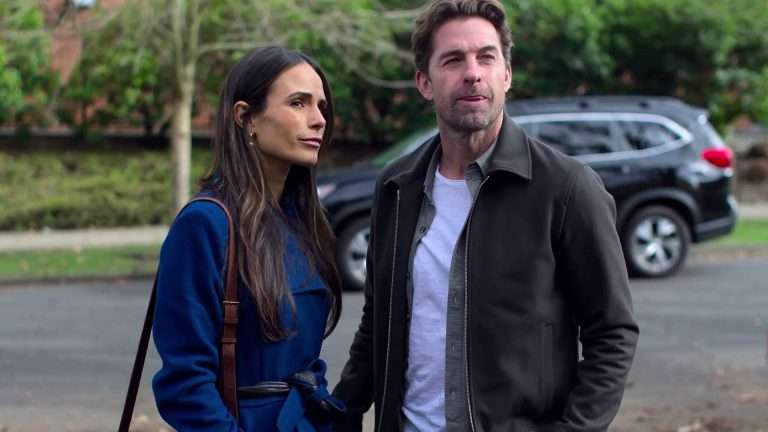America Is Waiting (2018) Review: Filmmaking is the art of remembering, and documenting people, through the medium of non-fiction or otherwise, which becomes an act of preserving collective memory. And so, when the camera turns towards a middle-aged white Trump supporter on a Washington street waiting for the swearing-in ceremony of his favorite president, he says, “Trump is good. All of those immoral acts, not great acts, I don’t know of.” In illuminating the ignorance, filmmaker Georg Koszulinski attempts to subtly reveal the truth with his film America is Waiting.
With a camera in his hands and a couple of microphones, Koszulinski walks through the streets of America, which present a different picture than the glossed-up one about the White House. There are protestors all over, and other people of different faiths and races standing in solidarity with them, standing against the newly-elected leader of America. The reason- he is none other than Donald Trump, whose ‘era’ of governance was marked by relentless fascism and a derogatory attitude towards minorities. The documentary, through the course of events of a single early morning, outlines how predictable it was all going to be.
The interviewer moves around several streets, questioning several individuals with signboards or sitting without anything in their hands about the reason for their presence. The focus mostly remains on the people who hit the streets to oppose the newly-elected and upcoming regime, although there are significant civil voices there supporting what has happened. The event in the political and democratic history of America that was absolutely memorable in all the wrong ways feels like a period drama, apparent from the late release of the film (it got completed in 2017 itself but released only this year).
America is Waiting is a deeply important film for its content. The events are long gone, and the archetypal fascist clown has been kicked out of the office. Still, his sheer presence triggers an entire history of sexual abuse (and bragging about it), which must be preserved for future generations to see and dodge over. The reluctance, fears, and anxieties of the protestors have been trumped by certain resilience and determination, which is largely the focus of Koszulinski’s approach. However, it is never altogether dismissive or challenging about the perspective of the majority which got Trump elected, circling around their (largely) authoritarian, ‘republican,’ and militarian reasons.
There are some virtues to the approach. For one, the editing is minimalistic, and there is an admirable patience toward what the people before the camera have to say. The art of listening virtually becomes the art of observance. When the people have relevant things to say which are going to take minutes of your time, the camera remains fixated on their face, often zoomed in, and never aimlessly meandering on the other lively happenings on the streets. Largely because everything political is also personal and intimately so.
It is also an admirably well-intentioned film, the safeness of which doesn’t count. The archival nature of each proceeding and the distance from the official workings tells us more about the insides of the White House than would be expected. While people are ashamed of living in a country that elected the wrong person just because he had something to say that was relevant to somebody, they are surely proud as hell for being the citizens of a country where they can say it with the kind of freedom and agency that they are allowed to exercise. Although with the election, the death of the same also feels nearly possible to them.
The non-white voices are the most compelling here, and the celebration of a Sikh man wearing an American flag turban to celebrate Trump isn’t ridiculed in comparison to a young Latina damsel leading the movement against the president that won’t be in the hearts of most in the upcoming years.
However, the lack of cinema sticks out like a sore thumb and ruins the entire viewing experience. The interviewing voice overwhelms the visuals, and the film feels like an introvert’s one-hour vlog in the absence of a structure, which clearly doesn’t work here. People are made to stand silently and look directly at the camera, which invites not a single moment of introspection or even conflict. The dialogues by the people and their feelings, however true, are stretched to the point of eternity. And since a lot of it goes unplanned and random, it also feels journalistic at best. This is why when the last shot moves towards a rail station, the feeling of watching a film largely vanishes in thin air.
Also, the film, despite overall being a celebration of radical and oppressed voices, misses the true spirit of protest. By deliberately choosing not to indulge in the activities of either side, its viewpoint feels fairly pedestrian, and those quiet moments of zoom-ins to the faces of random people being talked with most certainly don’t come to the rescue. Collecting experiences is a good thing, but collecting them by presenting a well-constructed front is even better and supportive. By merely recording the discourse without being artful enough, America is Waiting adds nothing to it.


![What Doesn’t Kill Us [2018]: ‘Locarno’ Review](https://79468c92.delivery.rocketcdn.me/wp-content/uploads/2018/08/WHAT_DOESNT_KILL_US1.jpg)



![Extraction [2020] Netflix Review: An effort that is mediocre at best](https://79468c92.delivery.rocketcdn.me/wp-content/uploads/2020/04/Extraction-cover-1-768x384.jpg)
![The Other Side of the Wind [2018] Review- Everything In Its Right Place](https://79468c92.delivery.rocketcdn.me/wp-content/uploads/2019/01/1469816-4170896-zoomed2-768x432.jpg)